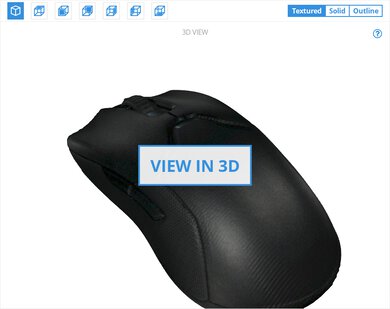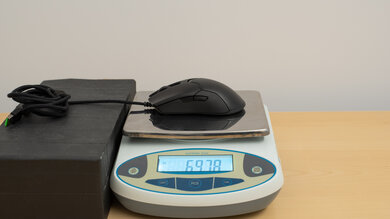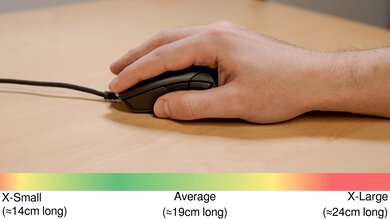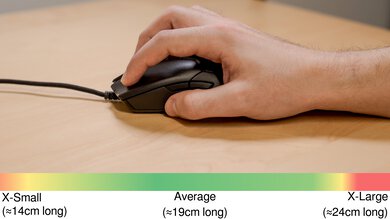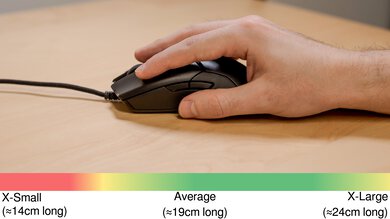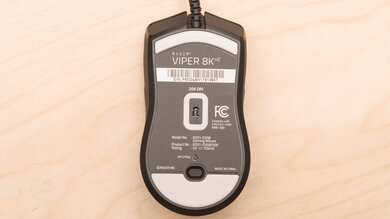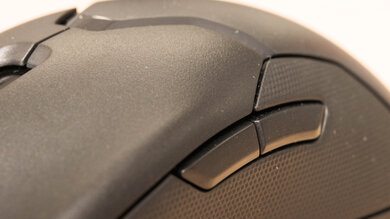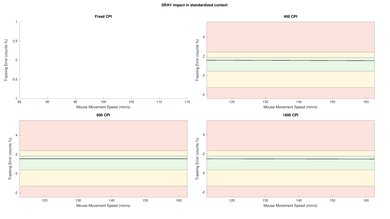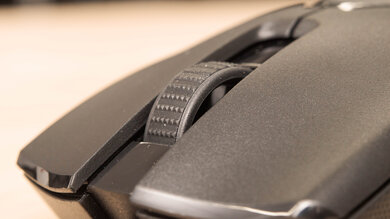The Razer Viper 8KHz is a lightweight, true ambidextrous mouse thanks to the two buttons on either side. It looks physically identical to the Razer Viper, but with a slightly thicker cable and smoother-gliding feet. It has an incredibly low click latency, a low lift-off distance, and a wide CPI range. Like the Razer Viper, it's suitable for most hand sizes when using a fingertip grip, but people with small hands may struggle to reach the L/R clicks and scroll wheel. What sets it apart from other gaming mice is its 8000Hz maximum polling rate, which produces smoother cursor movements and marginally lower click latency.
Our Verdict
The Razer Viper 8KHz is mediocre for office use. While it doesn't have an ergonomic shape like some dedicated office mice, it should still feel very comfortable for most hand sizes using a claw or fingertip grip and for small and medium hands using a palm grip. It feels very well-built and has many programmable buttons; unfortunately, its customization software isn't available on macOS. Also, it isn't wireless, and some people might find the cable cumbersome.
- Feels very well-built.
- Comfortable, ambidextrous design.
- Four programmable side buttons.
- Wired-only design may be cumbersome.
- Software isn't compatible on macOS.
- Cable isn't as flexible as some other options.
The Razer Viper 8KHz is excellent for FPS gaming. It's surprisingly very light for a mouse without a honeycomb design and feels very well-built. Its ambidextrous body has a low profile that's great for a fingertip grip, but small hands may struggle to reach some buttons. It has a wide and adjustable CPI range, an incredibly low click latency, and a low lift-off distance. Its 8000Hz maximum polling rate provides smoother and more consistent cursor movements than a gaming mouse with a standard 1000Hz polling rate.
- 8000Hz polling rate.
- Incredibly low click latency.
- Feels very well-built.
- Very light.
- Comfortable, ambidextrous design.
- Software isn't compatible on macOS.
- Cable isn't as flexible as some other options.
The Razer Viper 8KHz is very good for MMO gaming. While it doesn't have nearly as many side buttons as dedicated MMO mice, it does have two side buttons on either side, which is more than many other gaming mice. On the bright side, it has superb click latency, a wide and customizable CPI range, and a low lift-off distance. Also, it has an 8000Hz maximum polling rate, so cursor movements feel smoother and more consistent. It feels very well-built and very comfortable, but people with larger hands may struggle with a palm grip.
- 8000Hz polling rate.
- Incredibly low click latency.
- Feels very well-built.
- Comfortable, ambidextrous design.
- Software isn't compatible on macOS.
- Cable isn't as flexible as some other options.
- Not nearly as many side buttons as dedicated MMO mice.
- Feels very well-built.
- Cable isn't as flexible as some other options.
Changelog
- Updated Aug 19, 2025: We've converted this review to Test Bench 1.5.1. This update removes less relevant or redundant elements, including several videos. We've also adjusted our Sensor Latency testing, resulting in minor score changes. See our full 1.5.1 changelog for details.
- Updated May 07, 2024: We've added a link to the newly-reviewed Endgame Gear OP1 8k in the Hand Size Recommendation section of this review.
- Updated Jan 05, 2024: We've updated the CPI graph displayed in the Sensor Latency section of this review. Our results remain the same, but these graphs have two new columns with results from the Delay At Half Movement and Delay To End Of Movement tests.
- Updated Oct 02, 2023: We've added text to this review for the new tests added in TBU 1.5.
Check Price
Differences Between Sizes And Variants
The Razer Viper 8KHz has no variants, and it's only available in black. See the label of our unit here.
Popular Mouse Comparisons
While it has the same ambidextrous design as other mice in the Viper lineup, with buttons on both sides, the biggest difference with the Razer Viper 8KHz is its maximum polling rate of 8000Hz. It should provide even smoother cursor movements and less micro stutter than mice with 1000Hz polling rates. Apart from this, it has incredibly low click latency, a very wide and adjustable CPI range, and an extremely consistent sensor.
For other options, see our recommendations for the best gaming mice and the best wired mice, and if you'd prefer a wireless design, check out the best wireless gaming mice.
The Razer Viper 8KHz performs better than the Razer Viper Mini for most uses, though both mice look similar. The 8KHz is slightly bigger and feels a little more comfortable, especially if you have medium or large hands. Performance-wise, it has a much wider CPI range that you can adjust more precisely and with very little variation. It also has a lower lift-off distance and an outstanding maximum polling rate of 8000Hz, which results in smoother movement, though we don't test for this. Lastly, the 8KHz features two side buttons on each side, while the Mini only has two buttons on its left side. That said, the Mini is smaller and weighs a bit less, so it may be a better choice for people with smaller hands, especially those using a fingertip grip.
The Razer Viper 8KHz and the Logitech G PRO X SUPERLIGHT are both excellent FPS gaming mice. If you're a fan of ultra-light mice, the Logitech is worth considering because it's one of the lightest wireless mice we've ever tested. Also, it can be used both wired and wireless, and it's fully compatible with macOS. On the other hand, the Razer has RGB lighting, two programmable side buttons on each side, and marginally lower click latency. Also, it has an 8000Hz polling rate.
The Razer DeathAdder V3 and the Razer Viper 8KHz are wired gaming mice with extremely similar high-end gaming performance. The DeathAdder V3 is significantly lighter and has a right-handed shape. On the other hand, the Viper 8Khz has a symmetrical shape. Both mice support a maximum polling rate of 8000Hz.
The Razer Cobra and the Razer Viper 8KHz have the same symmetrical shape, but the Cobra is smaller. The Cobra is lighter and has RGB lighting, which the Viper lacks. On the other hand, the Viper 8KHz has a slightly more lightweight and flexible cable, better sensor accuracy, and it supports a higher maximum polling rate of 8000Hz.
Test Results

The Razer Viper 8KHz looks identical to the Razer Viper but has a thicker cable. Otherwise, it has the same ambidextrous, matte black design with two buttons on each side. It also has an RGB-lit logo on its back. If you're interested in a lightweight gaming mouse with RGB zones on either side of the mouse instead, check out the GLORIOUS Model O 2.
If you're interested in a wired mouse with similar performance but a right-handed shape with a taller profile and somewhat larger shape, check out the Razer DeathAdder V3.
It feels very well-built, similar to the Razer Viper. While there are no rattling or squeaky parts, our unit's plastic body exhibits some flex.
Despite not having a honeycomb design, the Razer Viper 8KHz is very light. It's only marginally heavier than the regular Razer Viper. If you're interested in an even lighter mouse with a maximum polling rate of 8000Hz, check out the HyperX Pulsefire Haste 2.
The Razer Viper 8KHz has a true ambidextrous design with two buttons on each side, exactly like the Razer Viper and the Razer Viper Ultimate. It has nice textured grips on both sides, and all of its buttons feel well-placed. Due to its short body, it's best suited for a claw or fingertip grip for most hand sizes, although people with small or medium hands may also feel comfortable with a palm grip.
If you're interested in a wired-only gaming mouse that offers similarly outstanding raw performance but has a slightly smaller symmetrical shape with a low-profile hump positioned slightly closer to the rear, see our review for the Endgame Gear OP1 8k.
The Razer Speedflex cable on the Razer Viper 8KHz is basically identical to other cables in the Viper lineup, but it's slightly thicker. It's fairly flexible, but it retains kinks from the packaging.
The Razer Viper 8KHz's virgin grade PTFE feet glide very smoothly on both mouse pads and directly on desks. They're much better than the ones on the regular Razer Viper.
This mouse's left- and right-click buttons use Razer Optical Mouse Switch Gen 2 switches.
Every button can be reprogrammed on this mouse, including all four side buttons, the CPI switch on the underside, and the up/down scrolls. Also, you can set a HyperShift button that gives you a second layer of programmable inputs for as long as you hold it. While you can reprogram the left click, you need to reassign the left click action to another button first.
The Razer Viper 8KHz has exceptionally low click latency. It's also extremely consistent when using the maximum 8000Hz polling rate setting, which is the setting used for this test. Overall, this mouse provides an incredibly responsive experience for gaming, regardless of genre.
The Razer Viper 8KHz has a very wide CPI range that can be adjusted fairly precisely in increments of 50. It also has a low lift-off distance, so the sensor shouldn't track your movements when repositioning your mouse.
The biggest difference with the other Razer mice is the polling rate: along with the usual 125Hz, 500Hz, and 1000Hz, it can also be set to 2000Hz, 4000Hz, or 8000Hz. Using higher polling rates produces smoother cursor movements and marginally improves click latency.
If you're interested in a gaming mouse that supports a wireless maximum polling rate of 8000Hz, check out the Razer Viper Mini Signature Edition.
The clicks are quiet and shouldn't bother people around you, even in a noise-sensitive environment.
The Razer Synapse 3 software is great and very user-friendly. You can easily customize most aspects, including the buttons, RGB lighting, set CPI, and polling rate. You can save your settings on the mouse's onboard memory, so all your customizations will remain when switching to another computer. Unfortunately, the software isn't available on macOS.


